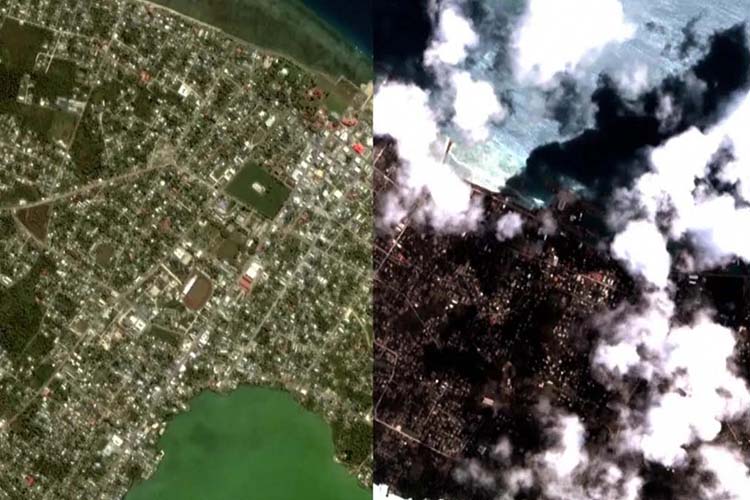
The Island of Tonga, before and after the eruption. photo courtesy of South China Morning Post
A historic eruption of an underwater volcano has left the Kingdom of Tonga in shambles, leaving the community in an attempt to rebuild.
The Kingdom of Tonga is a small island located in Oceania and a part of an archipelago referred to by some as the “Friendly Islands.”Tonga truly is a tropical paradise; it houses biodiverse forests, rich coral reefs, humpback whales, and radiant cultures with a rich history. On January 15th, this remote island was severed from the world, as it became suffocated by ash and entered a state of perilous crisis. Hunga Tonga-Hunga Ha’apai, (Hunga Tonga), a massive underwater volcano, devastated the nation Islands of Tonga. The volcano, located about 40 miles North of Tonga’s capital, erupted with a force of ten megatons according to a NASA assessment. For reference, this indicates that the explosion of Hunga Tonga was hundreds of times more powerful than the Atomic bomb that was dropped on Hiroshima after World War II. This explosion gagged Tonga, along with massive destruction caused by the tsunami that was triggered.
Cleaning up the ash and wrecked homes was only the beginning of the repairs; Hunga Tonga had completely destroyed Tonga’s connection to the rest of the world. The whole world is connected to one another by subsea fiber optic cables that span thousands of miles and are laid on the ocean floor, which allow for telecommunication signals to travel the globe. One of the biggest issues is that Tonga’s fiber optic cable, which not only connected them to the other islands in their archipelago, but the whole world, has been broken by the eruption. Tonga has been completely isolated from the globe. Luckily, neighboring countries have been sending their relief efforts, but for many, this posed unbearable stress. Many were unable to contact their friends and family to find out if they were safe. They were unable to communicate just how extensive the damage was and were completely isolated.
In an update released by the United Nations Office for the Coordination of Human Affairs, (OCHA), they reported three confirmed fatalities, many injuries, damage to over 100 houses, and infrastructure damage. The tragedy to the Kingdom of Tonga could have been much more devastating due to the magnitude of the blast, yet scientists believe that the destruction is far from over. Volcanologist Shane Cronin at the University of Auckland told Reuters news agency, “There is likely to be acid rain around Tonga for a while to come.” Cronin also noted that there will be erosion to the coastlines, long-lasting consequences on coral reefs, and impacts on fisheries regionally. One of the biggest issues that relief efforts have been trying to address is the lack of safe water for consumption and the cleanliness of the groundwater. This will undoubtedly affect the Tongan economy, as they rely on their agricultural export goods to sustain the economy. Two-thirds of their economic base is agriculture, including fisheries, with tourism following closely behind. After the eruption, it is safe to say that these are no longer feasible options to keep supporting their citizens. With tainted groundwater and massive destruction to amend, the two biggest economic sources of currency earnings are now destroyed for the time being.
Desperately needing aid, many countries stepped up to lend a hand. In a press statement, the U.S. Department of State thanked “our allies and partners, including Australia, Fiji, France, Japan, New Zealand, and the United Kingdom, for their leadership in providing immediate help and support.” Following this statement, the United States announced an aid package of $2.5 million dollars in addition to deploying ships with aid, similar to Australia and Britain. However, these relief packages could present a different type of danger than natural disasters: COVID-19 outbreaks.
Like the rest of the world, The Kingdom of Tonga is combating the COVID-19 pandemic. In March of 2020, Tonga had closed its borders and completely escaped community transmission, not having one single positive COVID-19 test. That was until they had to interact with the rest of the world in order to receive aid. As of February 6th, 2022, seven individuals had tested positive for the virus. In response, Tongatapu and Vava’u, (one of the Islands within the kingdom of Tonga), enforced an additional 14-day lockdown on February 2nd. This presents another challenge, specifically for the women of Tonga. Domestic violence is a massive issue; prior to the Pandemic, it was reported that 80 percent of Tongan women had experienced domestic violence in their lives, according to a study conducted by Pacific Women. According to the Director of the Women and Children’s Crisis Centre (WCCC), the first lockdown in 2020 “was a living hell for them.” The need for another lockdown will inevitably be the same for the women of Tonga, but luckily, crisis shelters have become more available for the women and children of Tonga.
Now that the dust has quite literally settled, The Kingdom of Tonga has to reconnect to the world, attempt to battle a pandemic, rebuild their nation, and keep their people safe. Hopefully, the Tongan Paradise will be rebuilt with a helping hand and a focus on some of the fundamental issues in their Kingdom.